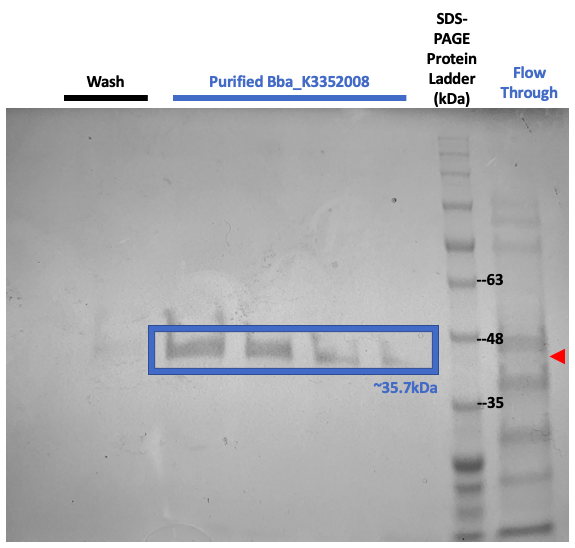Part:BBa_K3352003
|
|
T7 Terminator The T7 terminator is used in our constructs (BBa_K3352008) and (BBa_K3352009) to maximize protein expression. We obtained the sequence of this T7 terminator from pET vectors (Merck Millipore, formerly Novagen).
We improved the constructs (BBa_K3352006) and (BBa_K33352007) by using pET3a and pET11a vectors with appropriate BioBrick prefixes and suffixes that fulfill the assembly standard. The pET vector includes the T7 promoter, which promotes high level transcription. By utilizing both a T7 promoter, T7 terminator, and an extended UTR sequence around the RBS and before the terminator, we would maximize the protein expression for our enzymes. These composite parts were synthesized by GenScript.
Figure 1: T7 Terminator
We also aimed to improve this construct by using a pET3a and pET11a vectors with appropriate BioBrick prefixes and suffixes that fulfill the assembly standard. pET vectors include the T7 promoter, which promotes high level transcription [1]. By utilizing both a T7 promoter, T7 terminator, and an extended UTR sequence around the RBS and before the terminator, we can maximize protein expression for our enzymes (Figure 2) [1]. These composite parts were synthesized by GenScript.
Figure 2: Characterization of the pET T7 promoter with Φ29 polymerase (BBa_K3352009) construct and pET T7 promoter with SplintR (BBa_K3352008). We digested both constructs at the XbaI and PstI sites. The part (BBa_K3352001) was ligated into a pET11a backbone that is about 5500bps to form part (BBa_K3352009). Similarly, the part (BBa_K3352000) was ligated into pET3a backbone with a size of 4400bps which forms part (BBa_K3352008).
We transformed our plasmids into BL21(DE3) E. coli cells. We grew bacterial cultures overnight at 37°C, diluted them to an OD600 of 0.2, and then grew them to 0.5, where we collected a sample of 1mL. We then added IPTG and grew the cultures for another 4 hours. After the additional 4 hours, we then collected another 1mL sample. We centrifuged both samples and resuspended the pellets in 1x Sample Buffer. The samples containing IPTG expressed the protein more strongly, which suggests that our protein was present (Figure 3).
Figure 3: SDS-PAGE results show that SplintR ligase and Φ29 polymerase was expressed by E. coli. We grew the bacterial cultures overnight at 37°C, diluted them to an OD600 of 0.2, and then grew them to 0.5, where we collected a sample of 1mL. We then added IPTG and grew the cultures for another 4 hours. After the additional 4 hours, we then collected another 1mL sample. We centrifuged both samples and resuspended the pellets in 1x Sample Buffer. The sample with the IPTG expressed the protein more strongly, which suggests that our protein was present at 68.2 kDa.
We optimized the protein coding region for Φ29 DNA polymerase for high expression in E. coli. We also inserted 3 additional codons that should be present as found in the Φ29 DNA polymerase amino acid sequence in the parent organism Bacillus phage Φ29. To isolate the enzyme after expression, we added a N-terminal 6x histidine tag to the Φ29 DNA polymerase sequence through a GS linker (BBa_K3352001). This improves the existing Φ29 DNA polymerase sequence (BBa_K2918034) from team TUDelft 2019. To test whether our improved sequence was better, we expressed our Φ29 DNA polymerase (BBa_K3352009), which contains (BBa_K3352001) alongside TUDelft’s (BBa_K2918034) and analyzed the expression levels by SDS-PAGE. We grew bacterial cultures overnight at 37°C. We then diluted the cultures to an OD600 of 0.2 and grew them to an OD600 of 0.5, at which point we collected a 1mL sample. We then added IPTG and grew the cultures for another 4 hours after which another 1mL sample was collected. We centrifuged all samples and resuspended the pellets in 1x Sample Buffer and performed SDS-PAGE analysis. In our protein gel, we saw that our construct was able to better express Φ29 polymerase, especially after inducing it with IPTG, relative to the pre-existing part (Figure 4). To further confirm that the observed band was indeed Φ29 polymerase, we purified the enzyme using Ni sepharose affinity chromatography. The results showed a clear band at 68.2 kDa for the elution fractions that were not present in the flow-through or wash fractions, indicating that we successfully expressed and purified His-tagged Φ29 polymerase (Figure 5).
Figure 4: Comparison between part (BBa_K2918034) and part (BBa_K3352009) showing our improved Φ29 construct. We can clearly see a band that is around 68kDa in the post-induced pET T7 promoter and Φ29 construct (red) that is not present in the post-induced TUDelft 2019 Φ29 construct (blue), which suggests that our construct can better express Φ29 DNA Polymerase.
Figure 5: Comparison between part (BBa_K2918034) and part (BBa_K3352009) showing our improved Φ29 construct. We can clearly see a band that is around 68kDa in the post-induced pET T7 promoter and Φ29 construct (red) that is not present in the post-induced TUDelft 2019 Φ29 construct (blue), which suggests that our construct can better express Φ29 DNA Polymerase.
Figure 6: SDS-PAGE results show protein content at different steps of protein purification. A band around 35kDa was not present in the flow-through lane (red) or the wash buffer lanes, which corresponds with our expected His-tagged SplintR.
|
Secondary Structure
Measurement
- [http://openwetware.org/wiki/Cconboy:Terminator_Characterization/Results How these parts were measured]
| None |






